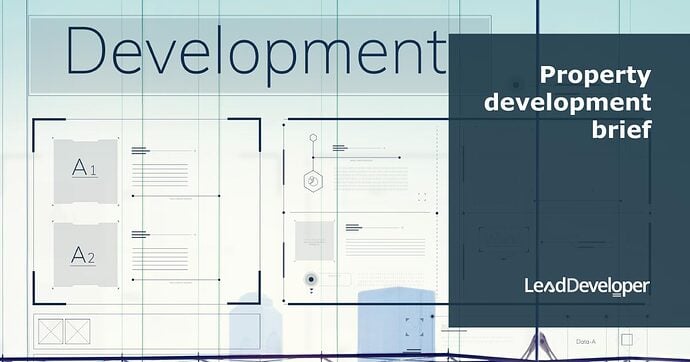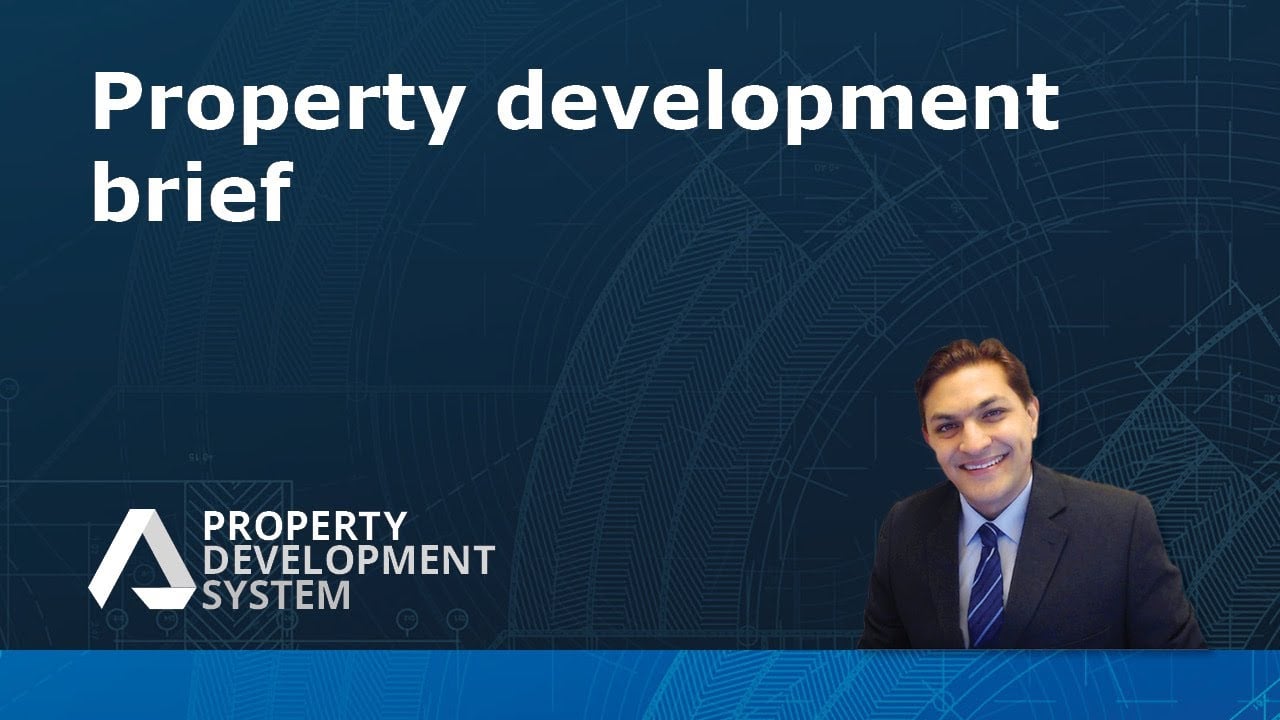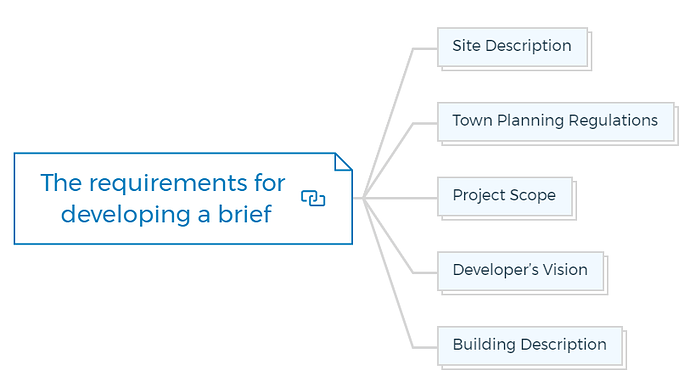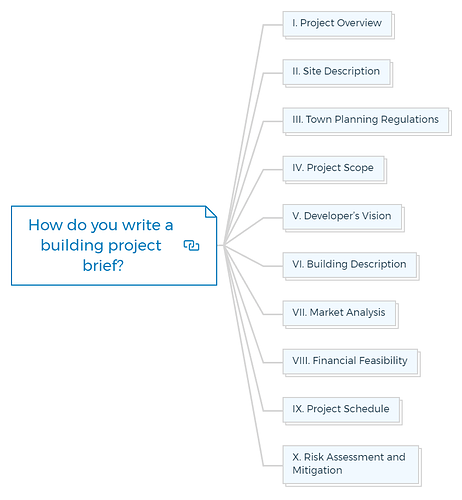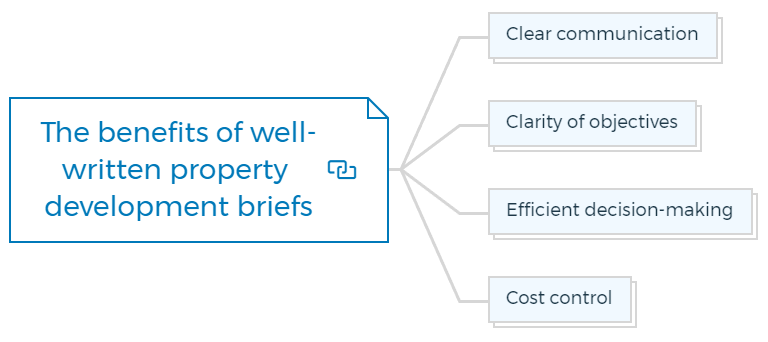Property Development Brief
Property development entails turning land or buildings into profitable assets. A well-written development brief guides your project from inception to conclusion, whether you’re an experienced developer or a newbie.
What is a development brief?
The development brief describes the project’s key objectives. Moreover, it highlights the development’s outlines and vision and how it responds to the market.
What are the requirements for developing a brief?
Below mentioned are some key features that are included in a complete development brief:
Site Description
- A site description would include:
- Site Plan
- Site Survey
- Google Maps - Highlighting the Site
- Existing boundary
- Other site specifications
Town Planning Regulations
Town planning and regulations – aspect in a development brief includes:
- Zoning & Overlays
- Conditions and Covenants
Project Scope
List of tasks to be completed before construction with clear objectives.
Developer’s Vision
This aspect of the development brief includes:
- Strategies
- Objectives, beliefs, and visions
Building Description
Building description highlights the influential features and factors such as:
- Building Form
- External theme and aesthetics
- Internal character and design
- Handicap provisions
It is highly advisable to hire an experienced consultant to carry out this aspect of the property development process.
You are missing out if you haven’t yet subscribed to our YouTube channel.
How do you write a building project brief?
The Council is the lead organisation in the production of a Development Brief. However, depending on the area of land to be considered, a landowner, developer or agent may investigate and prepare a Development Brief with assistance and in consultation with the Council.
The preparation of a development brief is not a single-force task. Instead, it’s a collaborative effort made with the alliance of the Council, the developers, and the public through the liaison groups. The development brief will take into consideration different iterations and processes.
Moreover, the developer’s team will consist of the collective drawings influenced and contributed by the involved parties. We will rigorously check and edit the drafts.
The development brief then is only adopted if you are happy with its content. One thing to pay attention to here is that any development brief that the Council hasn’t adopted would have a limited impact on future decision-making.
I. Project Overview
Start your development brief with a quick but thorough project summary. Add these details:
- Project Name: Give your development a memorable name.
- Location: Include the city, state, and any landmarks or benefits.
- Objectives: Set project goals like building residential or commercial spaces, revitalising a neighbourhood, or maximising land use.
II. Site Description
Detail your development site. Add these:
- Land Area and Boundaries: Indicate the site’s square metres or acres and boundaries.
- Topography: Describe slopes, natural features, and any potential limits.
- Infrastructure: Check water, electricity, sewerage, and road access.
III. Town Planning Regulations
Property developers must understand and follow town planning regulations. Consider the following:
- Zoning and Land Use: Determine your site’s zoning and land use constraints.
- Building Codes and Standards: Learn local building, design, and safety codes.
- Environmental Considerations: Assess environmental rules that may affect your project, such as ecological preservation or waste management.
IV. Project Scope
Define your development project’s magnitude, goal, and components. It includes:
- Residential or commercial: Indicate if the project is residential or commercial.
- Units or Spaces: List the planned development’s units, floors, or square footage.
- Amenities and Facilities: List amenities like parking, common areas, and recreational spaces.
V. Developer’s Vision
Explain the project’s values, aesthetics, and influence. Consider the following:
- Mission Statement: Explain the development project’s goal.
- Design Philosophy: Explain your design philosophy and architectural style.
- Sustainability and Innovation: Highlight eco-friendly or innovative design and building practices.
VI. Building Description
Explain your development’s proposed buildings. Add these:
- Architectural Design: Describe the building’s aesthetics’ architectural style, materials, and characteristics.
- Floor plans: Show the building’s layout and functions.
- Key qualities: Emphasise the building’s unique or appealing qualities.
VII. Market Analysis
Understanding your development’s demand and potential requires a thorough market analysis. Study the following:
- Local Market Conditions: Assess supply and demand, pricing, and regulatory or zoning restrictions in the local real estate market.
- Competitor Analysis: Determine nearby developments’ strengths, limitations, and market positioning.
- Economic and Demographic Factors: Assess market stability and potential using demographic data, economic indicators, employment rates, and growth estimates.
Learn More
VIII. Financial Feasibility
A solid financial analysis is vital to project viability and profitability. Add the following:
- Development expenditures: Estimate land, permit, construction, marketing, and other expenditures.
- Revenue Streams: Consider residential or commercial sales, leasing income, and auxiliary services.
- Return on Investment: Estimate ROI using predicted sales or rental income, financing costs, and contingencies.
Learn More
IX. Project Schedule
Create a precise project timetable from land purchase to completion.
- Pre-Development: Due diligence, site surveys, funding, and permissions.
- Design and Construction Phase: Highlight architectural, engineering, construction, and infrastructure milestones.
- Marketing and Sales Phase: Describe the marketing strategy, sales launch, and sales target deadlines.
X. Risk Assessment and Mitigation
Assess and mitigate project risks. Consider:
- Regulatory and Legal Risks: Avoid delays and legal issues by knowing local laws, permits, and compliance requirements.
- Market Risks: Anticipate demand, pricing, and economic fluctuations.
- Project Risks: Assess construction and design risks, unexpected delays, cost overruns, and contingency measures.
Learn More
What are the benefits of well-written property development briefs?
Well-written property development briefs assist developers and other stakeholders. Key benefits:
Clear communication
A well-written brief facilitates developer-to-architect, engineer-to-contractor, and investor collaboration. It clarifies the developer’s vision, goals, and requirements, reducing miscommunication.
Clarity of objectives
Thorough development briefs clarify property development project goals. It specifies the desired goals, target market, functional requirements, and design preferences, helping all stakeholders collaborate.
Efficient decision-making
Developers may make informed judgements throughout the project’s lifecycle with a thorough brief. It evaluates design suggestions, material choices, budget, and other important factors. This speeds up decision-making and reduces costly mistakes.
Learn More
Cost control
A well-written brief helps developers set budgets and financial goals. It aids in cost-cutting, prioritising, and minimising waste. Developers can reduce expenses and increase ROI by knowing the financial aspects.
Conclusion
Crafting a comprehensive property development brief lays the foundation for a successful project.
By incorporating the essential components mentioned above, you’ll be equipped with the knowledge and direction needed to navigate the complexities of property development, minimise risks, and achieve your desired outcomes.
Remember, careful planning and thorough analysis are vital to unlocking the potential of your real estate project.
Test Your Knowledge
Property Development Brief: Practical Exercise
Objective:
This assignment aims to provide students with a practical understanding of crafting a property development brief. By simulating the development process, students will learn how to conceptualise, plan, and prepare a development brief that aligns with market needs and regulatory requirements.
Assignment Overview:
Students will act as property developers tasked with planning a new development project. The assignment is divided into three parts: research, development of the brief, and presentation.
Part 1: Research and Analysis
1. Market Analysis (Research Question)
Conduct a market analysis for a hypothetical location of your choice. Analyse local market conditions, competitor projects, and demographic trends. Use online resources, market reports, and demographic data to support your analysis.
2. Site Selection and Evaluation (To Do)
Using Google Maps and other online resources, select a suitable site for your development project. Describe the site’s location, size, topography, and current use. Evaluate the site’s potential for development, considering access to infrastructure and any environmental constraints.
3. Regulatory Compliance (Research Question)
Research the zoning and town planning regulations applicable to your selected site. Identify any overlays, conditions, or covenants that may affect the development. Summarise your findings and discuss how they will influence your project plan.
Part 2: Development of the Brief
4. Project Vision and Scope (To Do)
Develop a clear vision for your project. Determine whether the project will focus on residential, commercial, or mixed-use development. Define the project’s scope, including the number of units or spaces, amenities, and any unique features.
5. Design Philosophy and Sustainability (To Do)
Outline your design philosophy and approach to architectural style. Describe how your project will incorporate sustainability and innovation in its design and construction. Provide examples of eco-friendly materials or technologies you plan to use.
6. Financial Feasibility (To Do)
Prepare a preliminary financial analysis for your project. Estimate development costs, potential revenue streams, and return on investment (ROI). Discuss financing strategies and any economic incentives that could be leveraged.
7. Risk Assessment (To Do)
Identify potential risks associated with your development project, including regulatory, market, and project-specific risks. Propose mitigation strategies for each identified risk.
Part 3: Presentation
8. Development Brief Compilation (To Do)
Compile your research, analysis, and planning into a comprehensive development brief. Your brief should include sections on the project overview, site description, town planning regulations, project scope, developer’s vision, building description, market analysis, financial feasibility, project schedule, and risk assessment.
9. Presentation (To Do)
Prepare a presentation summarising your development brief. Highlight key aspects of your project, including the site, vision, design philosophy, financial analysis, and risk management strategies. Be prepared to discuss how your project responds to market needs and regulatory requirements.
Submission Guidelines:
- Submit your development brief in a PDF format.
- Include all research notes, financial calculations, and any supporting documents as appendices.
- Presentations should be no longer than 15 minutes and can be delivered via mail.
Assessment Criteria:
- Understanding of market analysis and site evaluation processes.
- Clarity and feasibility of project vision and scope.
- Incorporation of sustainable design principles and innovation.
- Accuracy of financial feasibility analysis and risk assessment.
- Quality of the development brief and effectiveness of the presentation.
